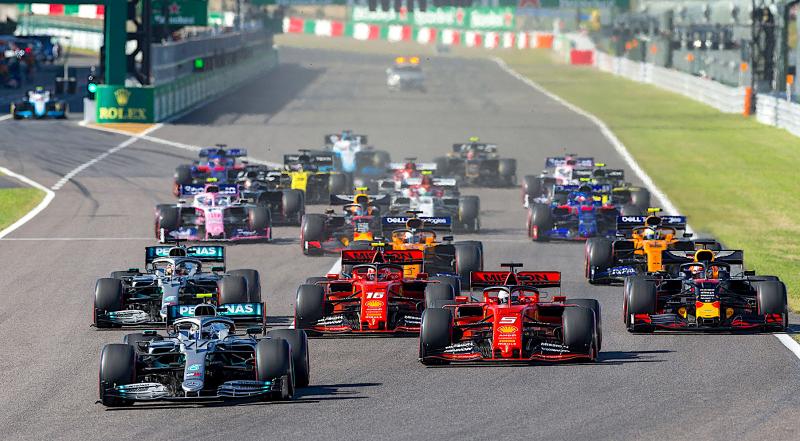Formula 1: Drive to Survive, Netflix review - thrilling documentary series wreaks havoc in the paddock | reviews, news & interviews
Formula 1: Drive to Survive, Netflix review - thrilling documentary series wreaks havoc in the paddock
Formula 1: Drive to Survive, Netflix review - thrilling documentary series wreaks havoc in the paddock
Ripping away the corporate facade of motorsport's gated community

The 2020 Formula 1 season will commence in Melbourne next weekend... unless the race is cancelled because of the mounting coronavirus panic. Everyone will have to self-isolate and watch Netflix instead, so how fortunate that the ‘flix has delivered this second series of Drive to Survive in the nick of time.
The first series last year was impressive, but this one seems to have taken a quantum leap upwards. Across the 10 episodes, it picks and probes at all the salient issues of F1, exploiting an amazing degree of backstage access and brilliant high-def action photography to reach back and forth across the 2019 season and knit together a sequence of penetrating short documentaries (episodes clock in at around 35 minutes). It’s as if every single individual on track or in the F1 paddock has been wired for Netflix’s sound, catching tiny moments like McLaren driver Carlos Sainz announcing “fuck you, Netflix” into his mini-microphone.
Ferrari and Mercedes opted out of the show last year, considering themselves too important, but this time they’ve seen the light and climbed aboard. But never mind them. By far the most fascinating material involves teams and drivers lower down the grid. It’s the dog-eat-dog zone where the teams are struggling for the track success which means commercial survival, while the ambitious young drivers strive to display the talents which will bring them a job higher up the ladder. However, the odds and their erratic machinery are heavily stacked against them.
 Guenther Steiner (pictured left), manager of the Haas team, emerged as an unforeseen star of series one, and keeps up the good work second time around. A man of explosive emotions expressed through a barrage of expletives, Steiner guides the team with, metaphorically speaking, a baseball bat wrapped in an iron glove. While nobody could love his drivers more when the going is good, it often isn’t. “This is not a fucking kindergarten here!” he rages. “Fucking everything is fucking up at the moment.” The darkest moment comes at Silverstone when the two Haas drivers, Magnussen and Grosjean, crash into each other, ending both their races. “I’ve fucking had enough of both of you!” steams Steiner. “You let the fucking team down!” But even Steiner quails before the black, forbidding stare of team backer Gene Haas, who fails to see the funny side of his funding going down the tubes.
Guenther Steiner (pictured left), manager of the Haas team, emerged as an unforeseen star of series one, and keeps up the good work second time around. A man of explosive emotions expressed through a barrage of expletives, Steiner guides the team with, metaphorically speaking, a baseball bat wrapped in an iron glove. While nobody could love his drivers more when the going is good, it often isn’t. “This is not a fucking kindergarten here!” he rages. “Fucking everything is fucking up at the moment.” The darkest moment comes at Silverstone when the two Haas drivers, Magnussen and Grosjean, crash into each other, ending both their races. “I’ve fucking had enough of both of you!” steams Steiner. “You let the fucking team down!” But even Steiner quails before the black, forbidding stare of team backer Gene Haas, who fails to see the funny side of his funding going down the tubes.
The reason Drive to Survive works so well is that it does what racing fans have been crying out for – it burrows deep into the guts of the sport and sweeps aside all those idiotically bland driver interviews (“Yes for sure, I know I can win”) and mendacious platitudes from team principals that was all anybody heard for decades. Followers of the sport might know which drivers are likely to be sacked or which teams might go bust, but here we see what that really means in excruciatingly personal terms.
 The spectacle of the once-mighty Williams team not managing to get its car built in time for pre-season testing is a demoralising sight for old-school fans, and Claire Williams’s forlorn attempt to put on a brave face only makes it worse (Claire Williams, pictured right). Who wouldn’t feel a pang of anguish for Nico Hülkenberg, crashing his Renault on the brink of what would have been his first-ever podium finish in 10 years in F1? Thanks to that, he’s now unemployed. And on the up side there’s the remarkable story of Anglo-Thai driver Alex Albon, dramatically promoted into the Red Bull team in mid-season while still living at home with his mother and sisters. Albon, a Buddhist, radiates an almost eerie calm, and is philosophical about the difficult years when his mother was imprisoned for fraud. There’s a brilliant little scene where a tabloid journalist tries to quiz Albon about this, and is told to sling his hook by Red Bull’s PR guy.
The spectacle of the once-mighty Williams team not managing to get its car built in time for pre-season testing is a demoralising sight for old-school fans, and Claire Williams’s forlorn attempt to put on a brave face only makes it worse (Claire Williams, pictured right). Who wouldn’t feel a pang of anguish for Nico Hülkenberg, crashing his Renault on the brink of what would have been his first-ever podium finish in 10 years in F1? Thanks to that, he’s now unemployed. And on the up side there’s the remarkable story of Anglo-Thai driver Alex Albon, dramatically promoted into the Red Bull team in mid-season while still living at home with his mother and sisters. Albon, a Buddhist, radiates an almost eerie calm, and is philosophical about the difficult years when his mother was imprisoned for fraud. There’s a brilliant little scene where a tabloid journalist tries to quiz Albon about this, and is told to sling his hook by Red Bull’s PR guy.
Hats off to F1’s owner Liberty Media Group for giving Netflix the green light to make this, even if it was only because Liberty has finally grasped that F1 needs to change or die. Although F1 has frequently been criticised for its aloofness and gated-community sterility, Drive to Survive illustrates that all of human life is in there, somewhere.
Add comment
The future of Arts Journalism
You can stop theartsdesk.com closing!
We urgently need financing to survive. Our fundraising drive has thus far raised £49,000 but we need to reach £100,000 or we will be forced to close. Please contribute here: https://gofund.me/c3f6033d
And if you can forward this information to anyone who might assist, we’d be grateful.

Subscribe to theartsdesk.com
Thank you for continuing to read our work on theartsdesk.com. For unlimited access to every article in its entirety, including our archive of more than 15,000 pieces, we're asking for £5 per month or £40 per year. We feel it's a very good deal, and hope you do too.
To take a subscription now simply click here.
And if you're looking for that extra gift for a friend or family member, why not treat them to a theartsdesk.com gift subscription?
more TV
 theartsdesk Q&A: director Stefano Sollima on the relevance of true crime story 'The Monster of Florence'
The director of hit TV series 'Gomorrah' examines another dark dimension of Italian culture
theartsdesk Q&A: director Stefano Sollima on the relevance of true crime story 'The Monster of Florence'
The director of hit TV series 'Gomorrah' examines another dark dimension of Italian culture
 The Monster of Florence, Netflix review - dramatisation of notorious Italian serial killer mystery
Director Stefano Sollima's four-parter makes gruelling viewing
The Monster of Florence, Netflix review - dramatisation of notorious Italian serial killer mystery
Director Stefano Sollima's four-parter makes gruelling viewing
 The Diplomat, Season 3, Netflix review - Ambassador Kate Wyler becomes America's Second Lady
Soapy transatlantic political drama keeps the Special Relationship alive
The Diplomat, Season 3, Netflix review - Ambassador Kate Wyler becomes America's Second Lady
Soapy transatlantic political drama keeps the Special Relationship alive
 The Perfect Neighbor, Netflix review - Florida found-footage documentary is a harrowing watch
Sundance winner chronicles a death that should have been prevented
The Perfect Neighbor, Netflix review - Florida found-footage documentary is a harrowing watch
Sundance winner chronicles a death that should have been prevented
 Murder Before Evensong, Acorn TV review - death comes to the picturesque village of Champton
The Rev Richard Coles's sleuthing cleric hits the screen
Murder Before Evensong, Acorn TV review - death comes to the picturesque village of Champton
The Rev Richard Coles's sleuthing cleric hits the screen
 Black Rabbit, Netflix review - grime and punishment in New York City
Jude Law and Jason Bateman tread the thin line between love and hate
Black Rabbit, Netflix review - grime and punishment in New York City
Jude Law and Jason Bateman tread the thin line between love and hate
 The Hack, ITV review - plodding anatomy of twin UK scandals
Jack Thorne's skill can't disguise the bagginess of his double-headed material
The Hack, ITV review - plodding anatomy of twin UK scandals
Jack Thorne's skill can't disguise the bagginess of his double-headed material
 Slow Horses, Series 5, Apple TV+ review - terror, trauma and impeccable comic timing
Jackson Lamb's band of MI5 misfits continues to fascinate and amuse
Slow Horses, Series 5, Apple TV+ review - terror, trauma and impeccable comic timing
Jackson Lamb's band of MI5 misfits continues to fascinate and amuse
 Coldwater, ITV1 review - horror and black comedy in the Highlands
Superb cast lights up David Ireland's cunning thriller
Coldwater, ITV1 review - horror and black comedy in the Highlands
Superb cast lights up David Ireland's cunning thriller
 Blu-ray: The Sweeney - Series One
Influential and entertaining 1970s police drama, handsomely restored
Blu-ray: The Sweeney - Series One
Influential and entertaining 1970s police drama, handsomely restored
 I Fought the Law, ITVX review - how an 800-year-old law was challenged and changed
Sheridan Smith's raw performance dominates ITV's new docudrama about injustice
I Fought the Law, ITVX review - how an 800-year-old law was challenged and changed
Sheridan Smith's raw performance dominates ITV's new docudrama about injustice
 The Paper, Sky Max review - a spinoff of the US Office worth waiting 20 years for
Perfectly judged recycling of the original's key elements, with a star turn at its heart
The Paper, Sky Max review - a spinoff of the US Office worth waiting 20 years for
Perfectly judged recycling of the original's key elements, with a star turn at its heart

Comments
Excellent review Adam. I've
Yes, it's an education isn't